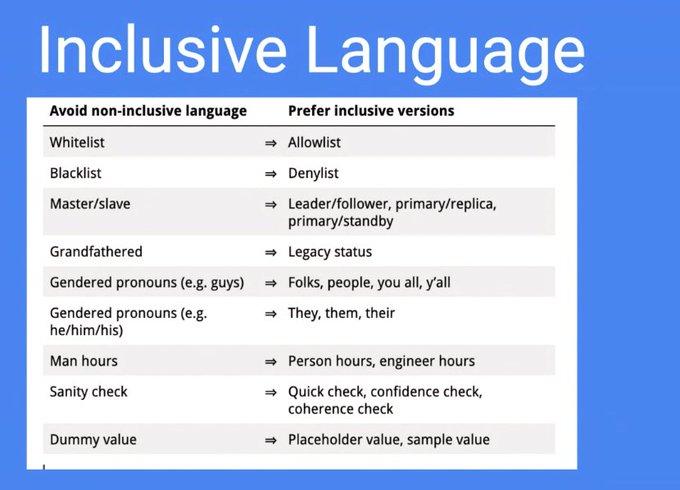Creating a healthy workplace environment and building an inclusive brand for your customers isn’t just an optional practice to target specific audiences.
As a marketer, creating messaging and practices in the workplace that promote diversity, equality, and inclusion are key to creating a strong organizational culture and powerful values.
One of the tools that helps to create inclusivity in your workplace is language.
Language is an incredibly powerful resource that can be used to help marginalized groups of people know they aren’t discriminated against.
When everyone can feel included, your brand can grow ethically and successfully in today’s modern business world.
But what exactly is inclusive language? Why is it important, and how can your brand utilize it within your company?
In this comprehensive inclusive language guide, we’ll answer those questions and take a look at the steps to begin using inclusive language in your organization, as well as examining some examples of inclusive language from other brands.
- What is Inclusive Language?
- Why is Inclusive Language Important for Businesses?
- Inclusive Language Guide: How to Use it For Your Brand and Business
- How to Promote Inclusive Language Within Your Company
- 3 Brands That Use Inclusive Language Successfully
- Wrap Up
What is Inclusive Language?
Inclusive language is defined as language that intentionally reflects openness towards differences by avoiding biases, expressions, or slang terms that discriminate against groups of people.
Types of discrimination that inclusive language avoids include references to race, gender, socioeconomic status, disability, age, sexual orientation, or other differentiators.
Inclusive language acknowledges the wide array of diversity in our world, and actively works to respect differences while promoting equality and opportunity for all people.
Without even knowing it, certain words or phrases we use can negatively impact the people around us.
Common Examples of Exclusive Language
In contrast to inclusive language, exclusive language is a language that discriminates against different groups of people.
Because many examples of exclusive phrases are common sayings, you may not even realize you are using them.
The graphic below gives some common examples of exclusive language and then alternative inclusive versions with the same meaning.

Why is Inclusive Language Important for Businesses?
It’s important to note that inclusive language is not an optional practice for businesses.
Inclusivity, diversity, and equality are important values that need to be represented in your company.
If they are not, you not only risk public image and ethical reputation damages, but legal damages as well if you are believed to be discriminatory.
Your brand should want to be as inclusive as possible to create a healthy work environment and foster an appreciation for people of different backgrounds.
Inclusive language is a key tool to communicate these values to your customers and internally to your teams across departments.
Without inclusive language, your brand doesn’t back up any of the core values you should be representing.
Inclusive language also helps to foster more trust and acceptance among your customer base.
Traditionally marginalized groups deserve to be included in brand values and within brand messaging.
Doing your part as a marketer to use inclusive language helps your brand become a leader in diversity and equality.
Additional Benefits for Your Business
In addition to ensuring that your brand values are important keys to creating a healthy environment, inclusive language can help in a few other areas as well:
- Attracting and retaining customers who value inclusion and diversity.
- Increasing productivity by creating a work environment that cares about individuals.
- Driving innovation by remembering to find inclusive solutions.
- Hiring and retaining the best people for jobs.
Inclusive Language Guide: How to Use it For Your Brand and Business
Now that you understand what inclusive language is and why it’s important for your brand, let’s take a look at different ways to start incorporating more inclusive language into your business.
This inclusive language guide will give you important tips to help you begin or improve your inclusivity efforts.
1. Categories to Avoid in Brand Language
There are many different categories that are often referenced in brand language that should be avoided.
If your branding uses too many of the following categories and doesn’t allow for openness or reference diversity in these categories, you may need to take a step back and reevaluate your language.
- Age
- Class
- Socioeconomic status
- Disabilities
- Gender
- Sexual orientation
- Race
- Ethnicity
- Religion
- Body size
2. Avoid Mentioning Personal Characteristics
As referenced above, there are certain categories of characteristics that you should avoid using in your brand language, or, if you need to address them, be as inclusive and general as possible.
Make sure that you only reference things like race, gender, or ability in relevant contexts.
3. Stay Away From Gendered Language
One of the quickest wins your business can implement with inclusive language is avoiding specific references to gender and keeping your language gender-neutral.
That means using “they” pronouns when referring to individuals in your messaging and avoiding assigning gender to anyone you communicate with.
Here are some common examples:
- Guys → People, folks
- Wife/Husband → Spouse
- Girlfriend/Boyfriend → Partner
- Chairman → Chairperson
- She/hers/her and he/his/him → They/them/their
4. Be an Ally
Another way to help improve your inclusive language use is to be an ally to diverse or marginalized groups.
By taking the time to learn more about different groups of people and respecting their identities and orientations, you can start to organically find other areas of branded language that can be made more inclusive.
5. Amplify Marginalized Voices
Being a good ally is more than just learning and supporting marginalized people, but also includes helping their voices be heard.
Rather than speaking over different groups, use your position to help their stories reach more audiences.
As a marketer, this can mean helping different individuals within your organization have company spotlights, giving credit where credit is due, and promoting influencers or users from diverse backgrounds in your content or social media marketing strategies.
6. Use Plain Language
Colloquial phrases and expressions might be clear to certain groups of people, but those from a different language or cultural background might not always understand colorful metaphors.
In order to be more inclusive, it’s important to use plain language in communication that is easily understood by all readers.
7. Give Options in Forms
One of the biggest areas of discrimination in marketing comes from the online forms that are required to fill out.
When there aren’t many options available for different identification categories, your customers and internal team members can feel left out.
Reviewing all your forms and creating diversity by using inclusive language and giving a variety of options for answers can help you avoid unintentionally discriminating against others.
It helps new users of your brand know that their identity and voice matter to your company, and further establishes your values of inclusion, diversity, and equality.
8. Put People First
The language constructions we use can sometimes communicate the wrong idea.
For example, saying “blind person” can make people feel like their disability or other characteristic is more important than their own individuality.
By literally putting “person” first to say “a person who is blind” will help to ensure your workplace culture values people over characteristics.
9. Avoid Inauthenticity and Tokenism
As with all other business practices, if you can’t back up what you promote, your brand reputation will suffer.
Inclusive language needs to be authentic.
It doesn’t do your company any good to avoid gendered language in your external messaging and not your internal communications, or to include different races and ethnicities in your marketing images, but not in your hiring practices.
Inclusivity is a continual and important value that needs to have an impact in all areas of your brand.
While having an inclusive language is a big step in communicating your intentions to internal teams and your customers, it’s also important to avoid doing so just to try and win over your audiences without appreciating the meaning behind it.
If you don’t follow through or promote diversity in other areas of your business, you will appear inauthentic.
How to Promote Inclusive Language Within Your Company
Creating a healthy and organizational work environment doesn’t just happen by updating your language within marketing teams.
It’s important for you to promote inclusive language within your entire company.
Here are a few best practices to follow when bringing inclusive language to your brand:
Add an Inclusive Language Guide to Brand Guidelines
Inclusive language shouldn’t be in the hands of a single team or left to individual determinations.
Clear, relevant, and specific inclusive language policies should be added to your brand’s guidelines and orientation materials.
This helps to ensure that from the beginning the intentions of inclusive language are understood across your organization.
Make it Clear that Inclusive Language is a Priority
Company initiatives never last long if they aren’t priorities for leaders to establish.
Make it clear to your entire organization that inclusive language is a top priority and isn’t optional for any teams or departments to follow, but a company-wide policy.
Diversity Graphics and Images
While inclusive language is a key component of creating a more equal and healthy work environment, it is part of a much bigger picture.
Your graphics, images, and designs also need to be inclusive as well.
When you have representational images and designs to accompany your inclusive language, your internal teams will have a clearer picture of your values.
Review Company Communications
If you are just beginning to change some of your business’s common language uses, you may want to create a team, task force, or board that reviews company communication to ensure that the new inclusive language guide is being followed.
You can also hold company-wide meetings to go over any major mistakes.
Be Open to Feedback
One key element of creating an inclusive and diverse workplace is to listen to feedback.
You may have individuals within your organization who notice other areas of inclusive language that can be changed, or who have feedback on how your implementation is working.
Listening to critical feedback helps foster healthier work environments.
3 Brands That Use Inclusive Language Successfully
Using inclusive language and adapting business practices often includes some unlearning within your current company culture.
After all, as we discussed earlier, many exclusive phrases are used commonly without realizing they aren’t inclusive.
Here are three different examples of brands that have managed to incorporate inclusive language into their businesses.
1. Salesforce
The SaaS giant has worked hard to shift its internal communications to be more inclusive and promote diversity.
They have created a specific inclusive language advisory board that helps listen to internal and community feedback to further develop their language development within the company.
2. Apple
Apple has worked hard to become a leader in inclusive language by changing many of the common terminologies in their coding language, such as “whitelist”, “blacklist”, and “master and slave” relationships, among others.
They’ve also created a specific internal inclusive language guide that directly addresses many of the words used in products, coding, and projects.
3. Mastercard
Mastercard’s new program, True Name, works to help those who use different names than their current legal names.
The program allows people to choose the name on their credit cards, even if it differs from legal documents.
This helps to promote inclusion for non-binary or transgendered individuals who often experience discrimination in forms and documentation.
Wrap Up
Creating an inclusive and diverse workplace goes far beyond hiring practices and visual representations in your marketing collateral.
The words you use and the language you incorporate into your messaging are also key to promoting a more equitable brand.
As a marketer, it’s your job to ensure that everyone feels included in your brand message.
You can do good work to promote inclusivity and encourage other brands to follow your example by using this inclusive language guide as a starting point for changing the way language works in your business.
Creating a plural environment at your workplace is the first step towards building a brand centered around important diversity and inclusivity practices.
If you want more information about how we promote these important values at Rock Content, then read our blog on diversity and inclusion in the company.
As a brand, we are proud of our efforts and want to encourage our readers to see the steps they can start taking today.
![Inclusive Language Guide for your Business [+ Tips that Will Help you Adapt]](https://rockcontent.com/wp-content/uploads/2021/11/inclusive-language-guide-1024x538.png)






